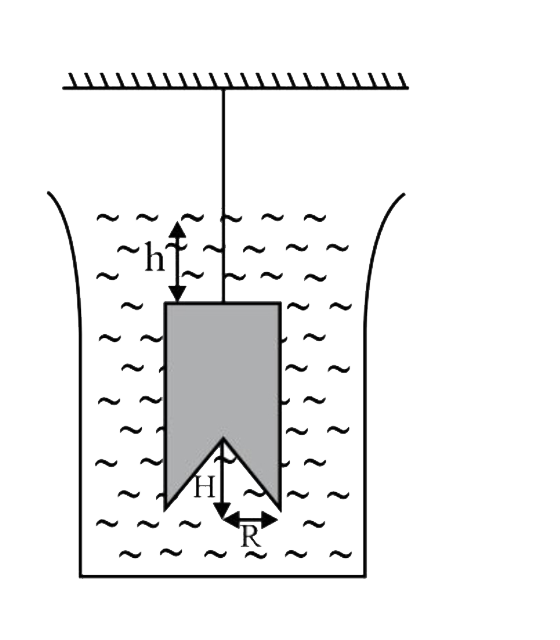A coaxial cylinder made of glass is immersed in a-liquid of surface tension S. The radius of the inner and outer surface of the cylinder are R1andR2 respectively . Height till which liquid will rise is (Density of liquid is ρ )
2SR2ρg
2SR1ρg
S(R2−R1)ρg
2S(R2−R1)ρg
The correct Answer is:D
To solve the problem of determining the height to which a liquid will rise in a coaxial cylinder due to surface tension, we can follow these steps:
1. Understanding the Setup:
- We have a coaxial cylinder made of glass, with an inner radius R1 and an outer radius R2.
- The cylinder is immersed in a liquid with surface tension S and density ρ.
2. Concept of Capillarity:
- The phenomenon of liquid rising in a narrow space due to surface tension is known as capillarity.
- The height h to which the liquid rises in a capillary tube is given by the formula:
h=2Scosθρgr
where:
- S = surface tension of the liquid,
- θ = angle of contact,
- ρ = density of the liquid,
- g = acceleration due to gravity,
- r = effective radius of the capillary.
3. Determining the Effective Radius:
- In this case, the effective radius r is the difference between the outer and inner radii of the cylinder:
r=R2−R1
4. Angle of Contact:
- For a glass surface in contact with water, the angle of contact θ is 0∘.
- Therefore, cosθ=cos0∘=1.
5. Substituting Values into the Formula:
- Substitute r and cosθ into the height formula:
h=2S⋅1ρg(R2−R1)
- This simplifies to:
h=2Sρg(R2−R1)
6. Final Result:
- The height h to which the liquid will rise in the coaxial cylinder is given by:
h=2Sρg(R2−R1)
- We have a coaxial cylinder made of glass, with an inner radius R1 and an outer radius R2.
- The cylinder is immersed in a liquid with surface tension S and density ρ.
- The phenomenon of liquid rising in a narrow space due to surface tension is known as capillarity.
- The height h to which the liquid rises in a capillary tube is given by the formula:
h=2Scosθρgr
where:
- S = surface tension of the liquid,
- θ = angle of contact,
- ρ = density of the liquid,
- g = acceleration due to gravity,
- r = effective radius of the capillary.
- In this case, the effective radius r is the difference between the outer and inner radii of the cylinder:
r=R2−R1
- For a glass surface in contact with water, the angle of contact θ is 0∘.
- Therefore, cosθ=cos0∘=1.
- Substitute r and cosθ into the height formula:
h=2S⋅1ρg(R2−R1)
- This simplifies to:
h=2Sρg(R2−R1)
- The height h to which the liquid will rise in the coaxial cylinder is given by:
h=2Sρg(R2−R1)
Similar Questions
Knowledge Check
An infinite cylinder of radius ro, carrying linear charge density λ. The equation of the equipotential surface for the cylinder is
Ar=r0eπε0[V(r)+V(r0)]λBr=r0e2πε0[V(r)−V(r0)]λ2Cr=r0e−2πε0[V(r)=V(r0)]λDr=r0e−2πε0[V(r)−V(r0)]λA hemispherical portion of a radius R is removed from the bottom of a cylinder of radius R. The volume of the remaining cylinder is V and its mass is M. It is suspended by a string in a liquid of density ρ where it stays vertical . The upper surface of the cylinder is at a depth of h below the liquid surface. THe force on the bottom of the cylinder by the liquid is
AM gBMg−Vρ gCMg+ΠR2hgρDρg(V+ΠR2h)
A capillary tube with inner cross-section in the form of a square of side a is dipped vertically in a liquid of density ρ and surface tension ρ which wet the surface of capillary tube with angle of contact θ . The approximate height to which liquid will be raised in the tube is : (Neglect the effect of surface tension at the corners of capillary tube)
View SolutionA paper disc of radius R from which a hole of radius r is cut out is floating in a liquid of the surface tension S. The force on the disc due to the surface tension is
View SolutionA drop of liquid of density ρ is floating half-immersed in a liquid of density d. If σ is the surface tension the diameter of the drop of the liquid is
View SolutionA cylinder of radius R full of liquid of density p is rotated about its axis at w rad/s. The increase in pressure at the centre of the cylinder will be
View SolutionA capillary tube of radius r is lowered into a liquid of surface tension T and density ρ. Given angle of contact =0∘.
What is the potential energy acquired by the liquid in the capillary?
View SolutionA conical portion of radius R and height H is removed from the bottom of a cylinder of radius R. The volume of the remaining cylinder is V and its mass is M. It is suspended by a string in a liquid of density ρ where it stays vertical . The upper surface of the cylinder is at depth h below the liquid surface . The force on the bottom of the cylinder by the liquid is

View Solution
